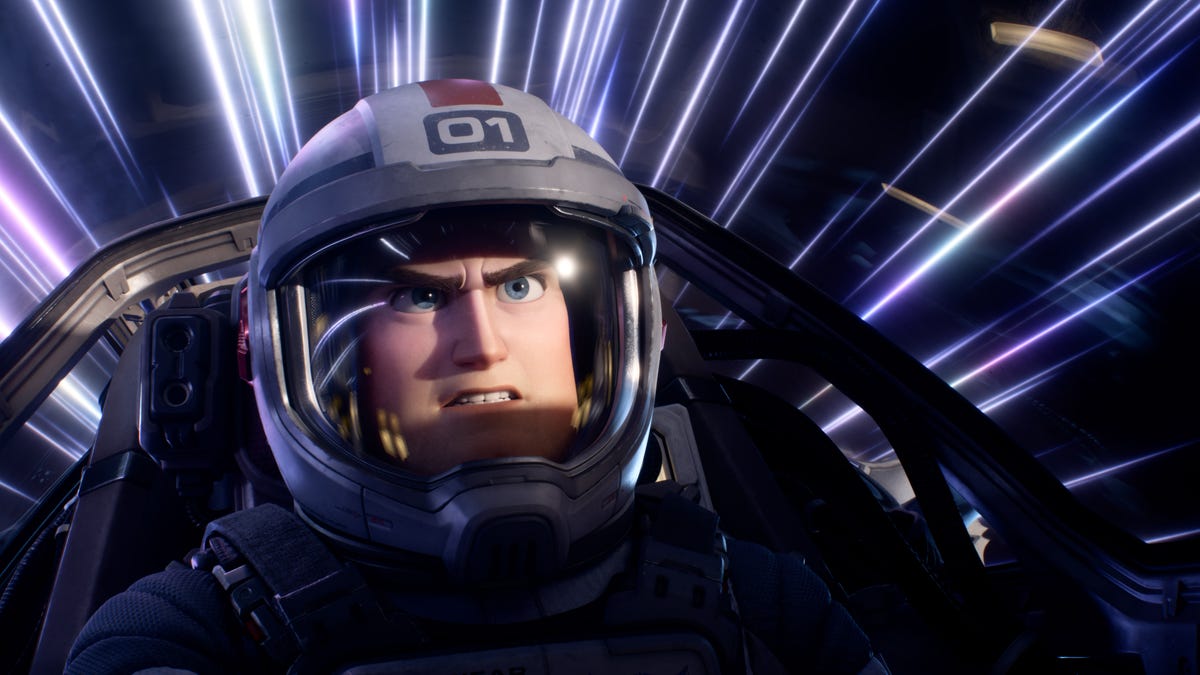Pixar's 'Lightyear' Shows How Far the Studio Has Come Since 'Toy Story'
Two decades of innovation has made it possible to bring the iconic toy to life as a human character -- all while pushing through new animation challenges.

To infinity, and beyond.
Pixar's Toy Story made history in 1995 as the first feature-length computer animated film. But there's a reason the studio focused on animating toys instead of people: it was a lot harder to make humans look realistic.
Twenty-seven years later, Pixar's newest project, Lightyear, flips the script. The film, which opens in theaters June 17, tells the story of the space ranger who inspired the beloved Buzz Lightyear toy. The primary cast of detailed, lifelike characters reflects how far Pixar's technology has come.
"I worked on some of those first human characters [in Toy Story], and I'm not proud," Lightyear producer Galyn Susman joked during a press event.
The Toy Story franchise, which spans four critically-acclaimed films, cemented Pixar as a leader in animation. Through the decades, the studio has been pushing technical innovation while also adapting to a changing world. That was especially true when the COVID-19 pandemic forced Lightyear's filmmakers to shift their workflow.
"We didn't know if we would be able to produce a movie where everybody was sitting in their own homes," Susman said.
But, like everyone else, employees at Pixar learned to adapt. They figured out ways to draw and annotate in Zoom. This was critical for director and screenwriter Angus MacLane, who needed to be able to draw out pretty much everything he said. In the end, going virtual turned out to be quite advantageous, Susman noted.
"It used to be that every department had their own way of presenting and communicating," she said. "[Zoom] all of a sudden became this regulated way of being able to do things where you could use a handful of simple tools to communicate."
Exploring new territory
The sci-fi film follows the legendary space ranger, voiced by Chris Evans, as he and a crew of scientists and technicians end up stranded on a strange, hostile planet. Buzz blames himself for failing in his mission to get them off the planet, and takes it upon himself to keep trying, even when the rest of the crew decides to settle down and move on with their lives.
Given the Toy Story films' popularity, there's a lot of pressure riding on this project, Susman noted. "People really have an attachment to Buzz, so you certainly don't want to disappoint."
To dodge any of that pressure, MacLane focused on building a whole new story out of a beloved one. While the toy Buzz is known for being confident and comedic, Evans' Buzz is more serious and ambitious. He has a hard time letting go and accepting defeat, which leads him to feel dejected.
In designing the film, MacLane leaned into his love of sci-fi movies growing up, especially Star Wars. The aesthetic takes on a "kind of chunky, early '80s look," he said, which means edges are rounded, scenes are high-contrast and knobs, dials and buttons are very tactile.
MacLane started at Pixar during the making of Toy Story 2 and worked on each subsequent film in the franchise. That also helped to remove some pressure.
"Pedigree-wise, I didn't worry about, 'What business do I have working on the movie?'" he said. "It was more like, 'How do we make sure that the movie is really fun and really great?'"
Keeping the focus on what filmmakers would enjoy was especially important given how long the movie making process is.
"You can't chase an audience, because when they start making a movie for some kids, those kids are gonna grow up," MacLane said. "Because the movies take so long, you have to make the movie for yourself. What would we be excited about?"
The braids on commander Alisha Hawthorne were a fresh challenge for Pixar animators.
New animation challenges
Each Pixar project showcases a new technical innovation, and Lightyear is no exception. One of the biggest achievements was figuring out how to animate the braids worn by Buzz's comrade, commander Alisha Hawthorne.
"Grooming is still a developing art form in computer graphics. It's very complicated; it's very information-rich," Susman said. "We had a woman on our film that had a particular passion for being able to figure out the braids. It was this stunning masterpiece of working with tools and her coding and putting things together."
Susman added, "It was an important part of capturing who these characters are, so it was worth making the investment to really try to make them feel authentic."
It paid off. During a film preview, a woman in the audience remarked that she loved the hairstyle and could see herself wearing it. "You couldn't ask for more than that," Susman said.
Lightyear is the first Pixar movie to open in theaters since 2020's Onward, which came out just as the pandemic was taking hold. MacLane says he's glad this film will hopefully encourage people to go back out and support theaters.
"The love for film and for cinema and the theatrical experience is so much about what the movie is, because that's the way we saw these [sci-fi] movies originally," he said. "That's what I wanted to pass on."

